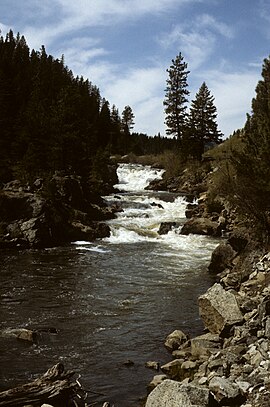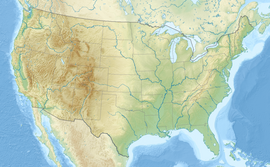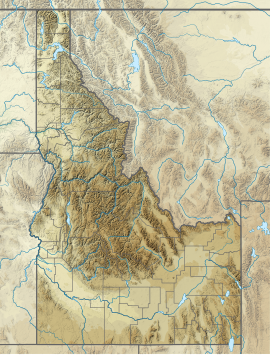This article needs additional citations for verification. (February 2013) |
The Little Salmon River is a tributary of the Salmon River in Idaho in the western United States.[1] The river is approximately 51 miles (82 km) in length and drains 576 square miles (1,490 km2) of land.[2]
| Little Salmon River | |
|---|---|
 A waterfall on the Little Salmon River | |
Location of the mouth in the United States | |
| Location | |
| Country | United States |
| State | Idaho |
| Region | Idaho and Adams counties |
| City | New Meadows |
| Physical characteristics | |
| Source | Blue Bunch Ridge |
| • location | Sawtooth Range, Adams County, Idaho |
| • coordinates | 44°50′28″N 116°15′46″W / 44.84111°N 116.26278°W |
| • elevation | 6,280 ft (1,910 m) |
| Mouth | Salmon River |
• location | Riggins, Idaho County |
• coordinates | 45°25′00″N 116°18′53″W / 45.41667°N 116.31472°W |
• elevation | 1,716 ft (523 m) |
| Length | 51 mi (82 km), South-North |
| Basin size | 576 sq mi (1,490 km2) |
| Discharge | |
| • average | 731 cu ft/s (20.7 m3/s) |
| • maximum | 12,600 cu ft/s (360 m3/s) |
| Basin features | |
| River system | Salmon River |
| Tributaries | |
| • left | Rapid River |
| • right | Goose Creek |
Course
editThe Little Salmon River rises at an elevation of 6,280 feet (1,915 m) above sea level on Blue Bunch Ridge in the Sawtooth Range of south-central Idaho, near Payette Lake. From there, it flows north through the broad Meadows Valley past Meadows and New Meadows, where it receives Goose Creek from the right and Mud Creek from the left.[3]
The river then enters a canyon, cutting across the western edge of the Salmon River Mountains, forming the boundary between Idaho and Adams counties. Most of the Little Salmon runs parallel to U.S. Route 95, with the highway crossing it several times. It receives Hazard Creek and Payette Creek both from the right, then receives Boulder Creek, the Rapid River, and Squaw Creek from the left, and past Pollock, then joins the Salmon River at the south end of Riggins, at 1,720 feet (525 m) above sea level.[1][3]
Discharge
editThis section needs expansion. You can help by adding to it. (February 2013) |
A U.S. Geological Survey stream gauge at the mouth recorded an average flow of 731.1 cubic feet per second (20.7 m3/s) from 1952 to present.[2] with a mean daily flow rate of 2500 cfs.[4] The highest flow ever recorded was 12,600 cu ft/s (360 m3/s) on June 17, 1974.[5][6][7]
Geology and land use
editThe Little Salmon River formed as a result of a rift valley developing between the Rocky Mountains and the Columbia Plateau section of the Intermontane Plateaus. Columbia River basalts underlie much of the western and central parts of the watershed, while other types of volcanic rock of closer origin form the foundations of the eastern mountains. The entire watershed is dissected by fault-block rifting. The water table is high, and soils are generally well drained and of volcanic origin.[3]
The upper section of the watershed is a broad and low-gradient, sediment-floored valley used primarily for agriculture and ranching activities. It also has most of the basin's population. The rest of the river flows in a wild, deep, and narrow canyon mostly undeveloped with the exception of US Highway 95. Logging has also been a past activity in the valley, and tourism and fishing are growing industries.[3] In a rare occurrence with rivers, the Little Salmon starts out in a developed, relatively flat area and flows through mountains further downstream, bearing some resemblance to the Klamath River, which also begins in an agricultural valley before cutting through mountains to the sea.[citation needed]
History
editHistorically, the Nez Perce, Shoshone, and Bannock Native American tribes inhabited the watershed of the Little Salmon River. Their lifestyle depended on the river for salmon and on the surrounding lands for other animals, as well as precious natural minerals and resources that provided them with items to trade. Europeans introduced horses to the Bannock, who in turn spread their use to the Shoshones, allowing them to travel further and hunt buffalo and other big game. Settlers began arriving in the 1850s and established farms, ranches and towns. Communications to the outside world was limited until the construction of roads and railroads in the early 20th century. Despite that, the region has still remained relatively isolated.[3]
The Payette National Forest and Nez Perce National Forest cover portions of the Little Salmon River watershed, but at no point does the river flow over federally protected lands. However, the river is also completely free flowing and unobstructed by dams or dikes. Most of the watershed receives about 20 to 25 inches (510 to 640 mm) of rainfall per year. On higher mountain slopes rainfall can be up to 40 to 50 inches (100 to 130 cm) annually, and on the highest west-facing mountains, precipitation can be much higher than that.[3] About half of the river is inhabited by namesake salmon, but at river mile 24.7 (river kilometer 39.8) Little Salmon Falls, at the confluence with Round Valley Creek, marks the end of the limit for anadromous fish. However, this barrier may have been different at some point in the past, because Native Americans have traditionally fished on the Little Salmon well upriver of the falls. Other than salmon, steelhead, Pacific lamprey, several different species of trout and dace, and other species of fish, are also present. Cottonwood, willow, dogwood and alder grow along the banks of the river.[3]
Hydrology
editIrrigation is now the primary water use in the Little Salmon River watershed. Although irrigated farmland lies all along the river, most of it is in the Meadows Valley and also in the watershed of Round Valley Creek, a major western tributary. There are 18,500 acres (75 km2) of irrigated farmland in the Meadows Valley and the Round Valley Creek area, and 700 acres (2.8 km2) closer to the mouth of the river. Although no dams have been built on the river, there are three dams in the headwaters of Goose Creek, a major tributary of the river, to regulate flows for irrigation water. The total water usage for irrigation is 74,800 acre-feet (92,300,000 m3) per year.[3]
Zoology
editLittle Salmon River is home to fish species such as Steelhead, Spring-Summer Chinook, and Rainbow Trout.The former two species are listed under the federal Endangered Species Act.
See also
editReferences
edit- ^ a b "Little Salmon River". Geographic Names Information System. United States Geological Survey, United States Department of the Interior. 1979-06-21. Retrieved 2010-01-19.
- ^ a b "USGS Gage #13316500 on the Little Salmon River near Riggins (Average Streamflow)". National Water Information System. U.S. Geological Survey. Retrieved 2010-01-19.
- ^ a b c d e f g h "Subbasin Assessment—Watershed Characterization" (PDF). Little Salmon River Subbasin Assessment and TMDL. Idaho Department of Environmental Quality. February 2006. Archived from the original (PDF) on 2009-10-02. Retrieved 2010-01-19.
- ^ Cooper, John E; Farrell, John M; Toner, Jason A (2004). "Predicting the Effects of Dam Removal on Aquatic Communities in the Salmon River, New York Phase 1 Baseline Data Final Report Grant 671 Submitted to the Great Lakes Protection Fund by: Predicting the Effects of Dam Removal on Aquatic Communities in the Salmon River, New York Phase 1 Baseline Data Final Report Grant 671". doi:10.13140/RG.2.2.21542.27201.
{{cite journal}}: Cite journal requires|journal=(help) - ^ "USGS Gage #13316500 on the Little Salmon River near Riggins (Peak Streamflow)". National Water Information System. U.S. Geological Survey. Retrieved 2010-01-19.
- ^ Bird, Kenton (June 17, 1974). "Rivers: the worst may be over". Lewiston Morning Tribune. (Idaho). p. 10.
- ^ "Swollen rivers expected to begin dropping". Lewiston Morning Tribune. (Idaho). June 18, 1974. p. 9.
External links
editMedia related to Little Salmon River at Wikimedia Commons

